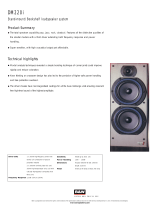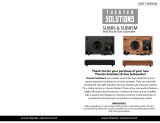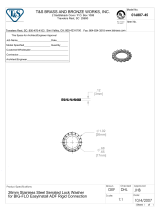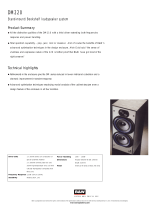Infinity TSS-Sub800 User manual
- Category
- Subwoofers
- Type
- User manual

TSS-Sub800
(TSS-800 SYSTEM)
SERVICE MANUAL
Infinity Systems Incorporated
250 Crossways Park Dr.
Woodbury, New York 11797 Rev0 9/2006

Note: The TSS-Sub800 is part of the TSS-800 system
Satellite loudspeakers:
(Charcoal) order Infinity part# TSS800CHR Sat-S-EP
(Platinum) order Infinity part# TSS800PLT Sat-S-EP
Center channel:
(Charcoal) order Infinity part# TSS-800CHR CEN-E
(Platinum) order Infinity part# TSS-800PLT CEN-E
CONTENTS
BASIC SPECIFICATIONS . . . . . . . . . ………………….………….... .. . . . . . 1
PACKAGING/ACCESSORIES. . . . . . . . . . . . . . . . . .………. . .. .. ... . . . . . 2
DETAILED SPECIFICATIONS . . . . . . . . . . . . . . . . . .………. . .. .. .. . . . . . 3
CONTROLS. ………………….. .. . …………………………………………….. 5
CONNECTIONS . . . . . . . . . . . ……….………………………………..…. . . . 6
OPERATION……. . . . . .. . . . . . . . .. .. . . . .. .. . . . . ….……… . . ... . . . . . . .7
EXPLODED VIEW-MECHANICAL PARTS LIST….… . ………………………..8
TEST SET-UP/PROCEDURE. . . . . . . . . . . . . . . . . .………. . .. .. .…. . . . . . 9
BLOCK DIAGRAM. . . . ………………... ………………………….... . . .. . … . 10
TROUBLESHOOTING FLOW CHART….… . ………………….………………12
PCB DRAWINGS. .. . . . . . . . . . . . . . .. . . . . ……………………………….. …13
ELECTRICAL PARTS LIST …………. ………………………………………….19
IC – TRANSISTOR PINOUTS . … . . .. . . . . . ………………………….... . . . 23
SCHEMATIC DIAGRAMS . . …………………………………….……………. . .24
TSS-Sub800 Specifications
Frequency Range: 34Hz – 150Hz (±3dB)
Amplifier Output: 150 watts RMS, 300 watts Peak
Low-Frequency Driver: 10" (254mm)
Crossover Frequency: 50Hz – 150Hz, 24dB/Octave, continuously variable
Dimensions (H x W x D): 15-3/4" x 14" x 15" (400mm x 356mm x 381mm)
Weight: 34.6 lb (15.7kg)
Infinity continually strives to update and improve existing products, as well as create new ones. The specifications
and construction details in this and related Infinity publications are therefore subject to change without notice.
TSS-Sub800
1

PACKAGING
TSS-Sub800
2

TSS-Sub800 100W Powered Sub/ Plate Amp
LINE VOLTAGE
Y
es/No Hi/Lo Line Unit Notes
US 120VAC/60Hz Yes 108-132 Vrms
Normal Operation
Europe 220-240VAC, 50-60Hz Yes 220-230 Vrms
Normal Operation
Parameter Specification Unit QA Test Limits Conditions Notes
Amp Section
Type (Class AB, D, other) AB AB
n/a 120V Model External heatsink required
Type (Class AB, D, other) G G
n/a 230V Model External heatsink required
Load Impedance (speaker) 4 Ohms
n/a Nominal
Rated Output Power 100 Watts
95 Single input driven
THD@ Rated Power 0.5 %
1 22K filter
THD @ 1 Watt 0.1 %
0.3 22K filter
DC Offset 10 mV-DC
50 @ Speaker Output
Damping factor >100 DF
100 50Hz-4 Ohms load
Measured at amplifier board speaker output
terminals, Output power 90 Watts.
Input Sensitivity
Input Frequency 50 Hz
50 Nominal Freq.
Line Input (L&R) 15.62 mVrms
±2dB To 1 Watt Single input driven, AP Zo=600 Ohms
LFE Input 10.36 mVrms
±2dB To 1 Watt LFE input driven only, AP Zo=600 Ohms
Signal to Noise
SNR-A-Weighted 100 dBA
85 rel. to rated power A-Weighting filter
SNR-unweighted 80 dBr
80 rel. to rated power 22K filter
SNR @ 1W-unweighted 60 dBr
60 rel. to 1W Output 22K filter
Residual Noise Floor 1.5 mVrms
2.5
Volume @max, using RMS reading
DMM/VOM (or A/P)
Residual Noise Floor 1
mVrms(max)
2
Volume @max, w/ A/P Swept Bandpass
Measurement (Line freq.+ harmonics)
Input Impedance
Line input L&R , LFE >10 K ohms
n/a Nominal
Filters
Low Pass (fixed or variable) 4th order --
±2dB
2nd order variable 50-150Hz + 2nd order
fix
Slope & Q dB/Octave
n/a
Subsonic filter (HPF) 2nd order fix Hz
±2dB
Slope & Q dB/Octave
n/a
Limiter (yes/no) YES --
Functional
THD at Max. Output Power 1 %
Functional
Features
LFE Input YES
Functional
Phase Switch (yes/no) YES --
Functional
Volume pot Taper (lin/log) LOG --
Functional
ATO YES
Functional
Input Configuration
Line In (L,R) L ,R --
Functional RCA inputs (L&R)
Line level in LFE LFE
Functional RCA single input
Signal Sensing (ATO)
Auto-Turn-On (yes/no) YES --
Functional
ATO Input Frequency 50 Hz
Functional
ATO Level 2 mV
Functional
@p
driven
ATO Turn-on time 5 ms
Functional
Amp connected and AC on, then input
signal applied
Auto Mute/ Turn-OFF Time 10 minutes
Functional T before muting, after signal is removed Auto turn of time (T) must be 5 > T <15
Power on Delay time 3 sec.
Functional AC Power Applied
Transients/Pops
ATO Transient 5 mV-peak
10 @ Speaker Outputs
Turn-on Transient 50 mV-peak
100 @ Speaker Outputs AC Line cycled from OFF to ON
Turn-off Transient 50 mV-peak
100 @ Speaker Outputs AC Line cycled from ON to OFF
Efficienc
y
Stand-by Input Power 14 Watts
18 @ nom. line voltage
Maximum allowable input power under
nominal Input voltage and frequency, HOT
or COLD operation.
Power Cons.@rated power 195 Watts
210 @ nom. line voltage
100 Watts @ 4 Ohms
TSS-Sub800
3

Parameter Specification Unit QA Test Limits Conditions Notes
Protection
Short Circuit Protection YES --
Functional Direct short at output
Thermal Protection 65 deg. C --
Functional @1/8 max unclipped Power
Temperature rise should not exceed 35K
rise
DC Offset Protection YES --
Functional DC present at Speaker Out leads Relay or crowbar (for driver/fire protection)
Line Fuse Rating
External fuse with UL/SEMKO rated holder
120 VAC 2.5 Amps
Type-T or Slo Blo, Fuse markings T2.5A,
250V
230 VAC 1.25 Amps
Type-T, Low breaking capacity, Fuse
markings T1.25AL, 250V
TSS-Sub800
4

A Few Suggestions
We recommend that you do not operate your speakers or
subwoofer with the bass, treble and loudness controls set to
full boost.This will place undue strain on your electronics and
speakers and could damage them.
The volume control setting on your processor/preamp or receiver
is not a specific indication of the overall loudness level of the
speakers.The only important consideration is the loudness level at
which the system can be played, regardless of where the volume
control is set.
Always turn down the volume control setting on your processor/
preamp or receiver when changing sources, or switching inputs to
AM or FM operation. Excessively loud transients (clicks or popping
sounds) can damage the satellite speakers and possibly the
subwoofer.
Important!
Whenever changing cables, pulling plugs,etc.,ALWAYS TURN OFF
ALL EQUIPMENT, including the subwoofer.
SUBWOOFER CONTROLS
Rear Panel
1
Subwoofer-Level Control
2
Crossover-Frequency Adjustment
3
Phase Switch
4
LFE Input
5
Line-Level Inputs
6
Power Indicator LED
7
Power Switch
TSS-Sub800
¡
™
£
¢
∞
¶
§
NRTU/C
C
SA22-2 NO.1
UL 1492
TSS-800 (120V) OM 2/24/06 10:01 AM Page 10
TSS-Sub800
5

SUBWOOFER CONNECTIONS
If your receiver/processor does not contain
a Dolby Digital or DTS processor but has a
subwoofer output:
N
N
O
O
T
T
E
E
: If your receiver/processor has only one sub out,
you may use either the L or R input.
If you have a Dolby
®
Digital or DTS
®
receiver/
processor with a low-frequency-effects (LFE)
or subwoofer output:
TSS-Sub800/230
SUBWOOFER OR
LFE OUTPUT
TSS-Sub800/230
RECEIVER/PROCESSOR
15' (4.5m)
subwoofer
cable
included
15' (4.5m)
subwoofer cable
included
TSS-800 (120V) OM 2/24/06 10:01 AM Page 11
TSS-Sub800
6

OPERATION
Surround Modes
When using the TSS-800 in a Dolby Digital or DTS home theater
system, make sure all speakers are set to “Small”. In a Dolby
Pro Logic
®
home theater system, make sure the receiver’s
center channel mode is set to “Normal.”
Some Dolby Digital-equipped receivers/processors offer different
setup options for each source or surround mode (e.g., CD-stereo,
videotape, Dolby, Pro Logic). In each case, follow your equipment’s
instructions to ensure that the subwoofer output is turned on and
that the speakers are set to “Small”in each mode.
Power On
Plug your subwoofer’s AC cord into a wall outlet. Do not use the
outlets on the back of the receiver.
Initially set the Subwoofer Level Control
1
to the“MIN”position.
Turn on the subwoofer by pressing the Power Switch
7
on the
rear panel.
Turn on your entire audio system and start a CD or movie sound-
track at a moderate level.
Auto On/Standby
With the Power Switch
7
in the ON position, the LED on the rear
panel
6
will remain lit in green or red to indicate the ON or
STANDBY mode of the subwoofer.
RED = STANDBY (No signal detected,Amp Off)
GREEN = ON (Signal detected,Amp On)
The subwoofer will automatically enter the Standby mode after
approximately 10 minutes when no signal is detected from your
system.The subwoofer will then power on instantly when a signal
is detected. During periods of normal use,the Power Switch
7
can be left on.You may turn off the Power Switch
7
for extended
periods of nonoperation, e.g., when you are away on vacation.
Adjust Level
Turn the Subwoofer Level Control
1
up about halfway. If no
sound emanates from the subwoofer,check the AC-line cord and
input cables.Are the connectors on the cables making proper
contact? Is the AC plug connected to a “live”receptacle? Has the
Power Switch
7
been pressed to the ON position? Once you have
confirmed that the subwoofer is active, proceed by playing a CD
or DVD. Use a selection that has ample bass information.
Set the overall volume control of the receiver/processor to a
comfortable level.Adjust the Subwoofer Level Control
1
until
you obtain a pleasing blend of bass. Bass response should
not overpower the room but rather be adjusted so there is
a harmonious blend across the entire musical range. Many
users have a tendency to set the subwoofer volume too loud,
adhering to the belief that a subwoofer is there to produce lots of
bass.This is not entirely true.A subwoofer is there to enhance
bass, extending the response of the entire system so the bass
can be felt as well as heard. However, overall balance must
be maintained or the music will not sound natural.An experienced
listener will set the volume of the subwoofer so its impact on
bass response is always there but never obtrusive.
Crossover Adjustment
The Crossover Frequency Control 2 determines the highest
frequency at which the subwoofer reproduces sounds. For the
TSS-800,it is recommended that this control be set at 120Hz
(approximately the 3 o’clock position).
NOTE: This control will have no effect if the LFE Input 4 is
used. If you have a Dolby Digital or DTS receiver/processor,
the low-pass frequency is set by the receiver/processor. Consult
your owner’s manual to learn how to view or change this setting.
A setting of 120Hz – 150Hz is recommended.
Phase Control
The Phase Switch 3 determines whether the subwoofer
speaker’s pistonlike action moves in and out with the main
speakers (0˚) or opposite the main speakers (180˚). Proper
phase adjustment depends on several variables such as room
size, subwoofer placement and listener position.Adjust the phase
switch to maximize bass output at the listening position.
Final Positioning
After correctly connecting the TSS-800 system and verifying that
both the subwoofer and all satellite speakers are playing, it is
time to optimize the system for your particular listening room.
Earlier, you placed the subwoofer in its general location. Finding
the exact location for optimum performance sometimes only
involves moving the speakers up to a few inches in any
direction.We urge you, therefore, to experiment with placement,
if possible, until your speakers deliver their full potential.
MAINTENANCE AND SERVICE
The satellite and subwoofer enclosures may be cleaned using a
soft cloth to remove fingerprints or to wipe off dust.
All wiring connections should be inspected and cleaned or
remade periodically.The frequency of maintenance depends on
the metals involved in the connections, atmospheric conditions
and other factors, but once per year is the minimum.
In the event that your TSS-800 ever needs service, contact your
local Infinity dealer or distributor,or visit www.infinitysystems.com
for a service center near you.
TSS-800 (120V) OM 2/24/06 10:01 AM Page 12
TSS-Sub800
7

TSS-Sub800
8

Test Set Up and Procedure
Equipment needed:
• Function/signal generator/sweep generator
• Integrated Amplifier
• Multimeter
• Speaker cables
General Unit Function (UUT = Unit Under Test)
1) From the signal generator, connect one line level (RCA) cable to the Subwoofer Line Level Input jacks L/R
on the UUT. Use a Y-cable from a mono source if necessary to connect to both inputs. Do not
connect to
the single LFE input.
2) On the amplifier, turn the LEVEL control full counterclockwise (MIN)
3) Turn the Crossover Frequency Adjustment full CW (150Hz)
4) Turn on generator, adjust to 100mV, 50 Hz.
5) Plug in UUT; turn the power switch ON. LED should be Red. Turn LEVEL control full clockwise (MAX)
6) LED should now be Green; immediate bass response should be heard and felt from bottom port tube
opening.
7) Turn off generator, turn LEVEL control fully counterclockwise, disconnect RCA cable.
Sweep Function
1) Follow steps 3-6 above, using a sweep generator as a signal source.
2) Sweep generator from 20Hz to 300Hz. Listen to the cabinet and drivers for any rattles, clicks, buzzes or
any other noises. If any unusual noises are heard, remove woofers and test.
Driver Function
1) Remove woofer from cabinet; detach + and - wire clips.
2) Check DC resistance of woofer; it should be 4.8 ohms ±10%
3) Connect a pair of speaker cables to driver terminals. Cables should be connected to an integrated amplifier
fed by a signal generator. Turn on generator and adjust so that speaker level output is 5.0V.
4) Sweep generator from 20Hz to 1kHz. Listen to driver for any rubbing, buzzing, or other unusual noises.
9
TSS-Sub800

TSS-Sub800
10

TSS-Sub800
11

TSS-Sub800 AMP
Troubleshooting Flow Chart
no
yes
yes
yes no
yes
yes
led red
led light green yes yes
no
yes yes no
no
yes
yes yes
no
no
yes yes
yes
no
yes
yes
AMP no signal out
Dc volta
g
e check ±Vcc
Check+/-15VDC
Led light green or red
Check Fuse,Transformer,
D110, etc
Check RY101,D102,Q113,Q114 etc
Check Q107,Q108,Q105,
Q106,Q103,Q104,U101,etc
Check ,+VCC& -VCC
DC voltage
Check U101,Q115,Q116,R138 etc
Check Q117,118,119,D109 etc
Check,Q206,Q207,U203 etc
Check U202 pin14 signal
Check U201
pin14 signal
Test R121,R122 signal
Check P102 signal The Amp ass’Y OK, END
CheckU201,U202,VR201
VR202. etc
Check J123,J124 etc
Check limiter board C304
Check U301,R343,R344 ,
C340,Q301,Q302, etc
Set R138 to R140’S
Voltage is 0.51VDC
TSS-Sub800
12

TSS-Sub800
13

TSS-Sub800
14

TSS-Sub800
15

TSS-Sub800
16

TSS-Sub800
17

TSS-Sub800
18

TSS-Sub800 (120v) Electrical Parts List
Part Number
Descriptio
n
Qty
Reference Designator
PREAMP PCB
Resistors
110-16102j26-e
Resistor 1k 1/6W ±5% CF 26mm (RoHS)
4
R213,R214,R215,R254
110-16103j26-e Resistor 10k 1/6W ±5% CF 26mm (RoHS) 12
R212.R216.R217.R220.R221.R222.R225.R228.R232.
R235.R240.R248
110-16104j26-e
Resistor 100k 1/6W ±5% CF 26mm (RoHS)
2
R231.R266
110-16105j26-e
Resistor 1M 1/6W ±5% CF 26mm (RoHS)
1
R259
110-16122j26-e
Resistor 1.2K 1/6W ±5% CF 26mm (RoHS)
1
R264
110-16151j26-e
Resistor 150OHM 1/6W ±5% CF 26mm (RoHS)
1
R253
110-16154j26-e
Resistor 150k 1/6W ±5% CF 26mm (RoHS)
1
R252
110-16183j26-e
Resistor 18k 1/6W ±5% CF 26mm (RoHS)
1
R262
110-16205j26-e
Resistor 2M 1/6W ±5% CF 26mm (RoHS)
1
R257
110-16223j26-e
Resistor 22K 1/6W ±5% CF 26mm (RoHS)
3
R247.R250.R255
110-16333j26-e
Resistor 33K 1/6W ±5% CF 26mm (RoHS)
1
R249
110-16472j26-e
Resistor 4.7K 1/6W ±5% CF 26mm (RoHS)
2
R258.R260
110-16473j26-e
Resistor 47K 1/6W ±5% CF 26mm (RoHS)
2
R219.R251
110-16512j26-e
Resistor 5.1K 1/6W ±5% CF 26mm (RoHS)
3
R211.R229.R230
116-161002f26-e
Resistor 10K 1/6W ±1% MF 26mm (RoHS)
1
R7
116-161471f26-e
Resistor 1.47K 1/6W ±1% MF 26mm (RoHS)
1
R4
116-161503f26-e
Resistor 150.0K 1/6W ±1% MF 26mm (RoHS)
1
R1
116-161542f26-e
Resistor 15.4K 1/6W ±1% MF 26mm (RoHS)
2
R237.R238
116-162400f26-e
Resistor 240OHM 1/6W ±1% MF 26mm (RoHS)
1
R2
116-162871f26-e
Resistor 2.87K 1/6W ±1% MF 26mm (RoHS)
1
R234
116-163602f26-e
Resistor 36K 1/6W ±1% MF 26mm (RoHS)
1
R233
116-165361f26-e
Resistor 5.36K 1/6W ±1% MF 26mm (RoHS)
1
R6
116-1664r9f26-e
Resistor 64.9OHM 1/6W ±1% MF 26mm (RoHS)
1
R5
116-166801f26-e
Resistor 6.8K 1/6W ±1% MF 26mm (RoHS)
4
R224.R223.R226.R227
116-168251f26-e
Resistor 8.25K 1/6W ±1% MF 26mm (RoHS)
2
R3
115-h203b208-e VR 20KB*2 (RoHS) CROSSOVER 1
VR202
115-h503a104-e VR 50KA*1 (RoHS) LEVEL 1
VR201
Capacitors
129-a104j633-e
metallize Capacitor 0.1uF 63V ± 5% MSC (RoHS)
2
C5.C215
129-a153j633-e
metallize Capacitor 0.015uF 63V ± 5% MSC (RoHS)
1
C224
129-a224j633-e
metallize Capacitor 0.22uF 63V ± 5% MSC (RoHS)
1
C216
129-a274j633-e
metallize Capacitor 0.27uF 63V ± 5% MSC (RoHS)
1
C218
129-a473j633-e
metallize Capacitor 0.047uF 63V ± 5% MSC (RoHS)
1
C4
129-a474j633-e
metallize Capacitor 0.47uF 63V ± 5% MSC (RoHS)
2
C221.C222
129-a823j633-e
metallize Capacitor 0.082uF 63V ± 5% MSC (RoHS)
1
C217
130-2b221k503-e disc Capacitor 220pF 50V +/-10% Y5P (RoHS) 9
C207.C208.C210.C211.C212.C214.C220.C230.C249
130-3f104z503-e
disc Capacitor 0.1uF 50V +80/-20% Y5V (RoHS)
7
C232.C242.C244.C245.C246.C252.C254
130-sl470k503-e
disc Capacitor 47pF 50V +80/-20% SL (RoHS)
1
C229
132-103j503-e mylar Capacitor 0.01UF 50V ± 5% (RoHS) 1
C223
135-3105m50-e electrolytic 1uF 50V ±20% 85℃ (RoHS) 1
C228
135-3106m50-e electrolytic 10uF 50V ±20% 85℃ (RoHS) 8
C206.C213.C219.C231.C241.C243.C251.C253
135-3107m16-e electrolytic 100uF 16V ±20% 85℃ (RoHS) 2
C233.C234
135-3226m50-e electrolytic 22uF 50V ±20% 85℃ (RoHS) 1
C225
Semiconductors
192-027c1815gr-e transistor 2SC1815GR TOSHIBA (RoHS) NPN 1
Q201.Q206.Q207
197-031n4148-e
diode 100mA 75V SIGNAL IN4148 ROHM (RoHS)
9
D201.D202.D118.D117.D207.D206.D211.D212.D214
199-15000335-e zener diode 3.3V 1/2W 52mm (RoHS) 1
D213
190-06m4558d-e IC OPA 4558 DUAL OP-AMP 1
U203
190-16ti074cn-e I .C TL074cm st QUAD OP-AMP 2
U201.U202
195-10204hgw-e LED Red-Green 204HGW ψ3(RoHS) 1
D209
TSS-Sub800
19
Page is loading ...
Page is loading ...
Page is loading ...
Page is loading ...
Page is loading ...
Page is loading ...
Page is loading ...
-
 1
1
-
 2
2
-
 3
3
-
 4
4
-
 5
5
-
 6
6
-
 7
7
-
 8
8
-
 9
9
-
 10
10
-
 11
11
-
 12
12
-
 13
13
-
 14
14
-
 15
15
-
 16
16
-
 17
17
-
 18
18
-
 19
19
-
 20
20
-
 21
21
-
 22
22
-
 23
23
-
 24
24
-
 25
25
-
 26
26
-
 27
27
Infinity TSS-Sub800 User manual
- Category
- Subwoofers
- Type
- User manual
Ask a question and I''ll find the answer in the document
Finding information in a document is now easier with AI
Related papers
-
Infinity SUB450 User manual
-
Infinity Total Solutions TSS-800 Owner's manual
-
Infinity PS Series User manual
-
Infinity Speaker System TSS-800 User manual
-
Infinity PS28 User manual
-
Infinity TSS-500OM User manual
-
Infinity TSS-450 User manual
-
Infinity TSS-1200 User manual
-
Infinity TSS-750 User manual
-
Infinity Total Solutions TSS-500 User manual
Other documents
-
JBL SUB200 User manual
-
 Bowers & Wilkins DM220i User manual
Bowers & Wilkins DM220i User manual
-
JBL Northridge E-Series E150P User manual
-
 Theater Solutions SUB8SM User manual
Theater Solutions SUB8SM User manual
-
Yamaha TSS-15 Owner's manual
-
JBL SUB500 User manual
-
 T & S Brass & Bronze Works 016807-45 Datasheet
T & S Brass & Bronze Works 016807-45 Datasheet
-
 Bowers & Wilkins DM220 User manual
Bowers & Wilkins DM220 User manual
-
JBL PowerBass PB12 Owner's manual
-
JBL PB12 User manual






























